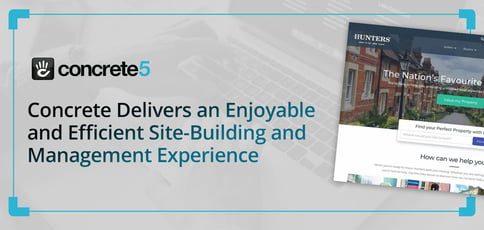
TL; DR: Concrete’s intuitive, open-source platform makes site building, maintaining, and editing as straightforward as working with a word processor. The free content management system (CMS) was designed to be simple enough for employees who lack tech chops yet powerful enough to serve the complex needs of developers. Fans should keep an eye out for the release of Concrete Version 9 early next year, which will feature a revamped user interface centered on ease of use.
Digital media and content creation go hand-in-hand in today’s online landscape, but that doesn’t mean that the skill sets required to build websites and craft engaging communication pieces are intertwined.
In an attempt to bridge the gap between developers and marketing teams, many companies have turned to content management systems (CMSs). These platforms are intended to help non-technical employees create, manage, and deploy content for blogs, corporate websites, ecommerce sites, and news sources, among other resources.

Concrete is as powerful as it is user-friendly.
The problem is that CMS platforms are typically created by developers who don’t understand how intimidating such systems can be for someone without programming experience. The result? Internal or external site-building teams often end up handing off sites to content teams that have no clue how to make basic changes, let alone add new functionality.
These types of scenarios either end in weeks of training or a perpetually inefficient back-and-forth communication system between siloed content and development teams. Either option leaves the business at a disadvantage.
Concrete, a free and open-source CMS, was created precisely with these challenges in mind.
“Concrete removes barriers in terms of who can add and edit content,” said Franz Maruna, CEO of Concrete. “The ability to quickly edit your own content opens up several possibilities — not just for saving time, but for visualizing other things you can do with your website.”
Franz told us that Concrete users often go from spending weeks updating their website with other tools, to just days using Concrete.
“A quarter or two later, that same client has gone from increasing productivity to adding new features, building and connecting apps to the site, or pulling data out of an API,” Franz said. “The potential is certainly there.”
A Powerful, Open-Source CMS Built for Usability
Concrete got its start as a full-service interactive media shop in the 2000s.
“If you could click it, we could build it,” Franz said. “The problem was, we didn’t like any of the tools that we were using to power our websites and let our clients edit them.”
By the end of each project, after a significant amount of money had exchanged hands, the team began to witness a familiar scene among content departments.
“We’d go in to do some final training, and we could just see the fear on everyone’s faces as they pulled out brand-new steno pads and rolled up their sleeves,” Franz said. “We felt like they had invested all of this trust and money in us so that they could express themselves and their ideas, but in the end, they were scared of the system they had purchased from us. That sucks for everyone. What kind of work do you get from a craftsman who hates their tools?”
In 2003, the team decided to start from scratch with a different type of CMS that would feature in-context editing, similar to the functionality of a word processor. The idea was to create a comfortable, natural user experience.
“We did away with telling people, ‘To change this press release, you’ve got to find it over here in the control panel,’ which always felt so painful,” Franz said. “We started with that concept in the first version of Concrete and proceeded to build all sorts of sites for various audiences.”
By 2008, the company switched gears, releasing the fifth major version of Concrete as free and open-source. The team released the code on SourceForge, a popular web-based open-source software repository that preceded GitHub.
“Within 90 days, we were the project of the month on SourceForge, and Clearwire (a telecommunications operator that later merged with Sprint) was using us for its whole web stack,” Franz said. “Planned Parenthood started using us after that, and since then, we’ve been moving from opportunity to opportunity.”
Trusted by Well-Known Brands Worldwide
Today, Concrete’s user portfolio includes the U.S. Army Installation Management Command (IMCOM), which delivers Morale, Welfare, and Recreation (MWR) programs designed to enable a globally-responsive Army. Concrete helps power IMCOM MWR websites for more than 100 U.S. Army garrisons across the globe.
“Many of them have several content editors, plus there’s a central enterprise group managing best practices,” Franz said. “MWR is essentially using one multisite installation to power all of these websites while providing a consistent user experience.”

Concrete powers the U.S. Army’s IMCOM MWR websites for garrisons across the globe.
Other Concrete users leverage the free software to create intranets and community systems and power web apps. The platform’s features, which include everything from intuitive editing and modular site building with a range of templates for marketing, SEO, and analytics tools, make it uniquely flexible.
“You can use Concrete to build anything; it’s ubiquitous, like a screwdriver,” Franz said. “But the type of client who gets the most benefit from it, I would say, is a website manager with a team of people. Concrete includes the ability to control complicated permissions and workflows.”
From the employee’s perspective, of course, the software is straightforward and easy to learn. Franz told us that training usually takes no more than a couple of YouTube videos and a pat on the back.
“A lot of larger organizations will say, ‘Look, we’ve got a lot of people that have varying levels of expertise, and we don’t want to have to funnel all the content through some guy in the basement; we want them to do it themselves,’” he said. “That’s where Concrete shines.”
Enabling Site Evolution Minus the Hassle
In that sense, Concrete has the potential to transform a website from a stale, dated piece to a living communications organism.
“We very often will see someone start with something simple — just getting a few pages online,” Franz said. “Fast-forward a year and a half, and that same site has become the central repository, the source of truth for all product data in the organization. It’s like building with Legos and continuously adding pieces.”
Franz told us that the ability to send nearly anyone with basic Microsoft Office skills to a site to make updates is one of Concrete’s most compelling aspects.
“We have clients tell us that working with Concrete is the best part of their day; that no one in the company used to update the website and now they look forward to it,” he said.
As sites evolve and grow, Concrete offers additional services designed to help developers cut down on tedious site-building and maintenance work while focusing on more advanced tasks. Tools like Express, available in the Concrete dashboard, help users manage data objects specific to the site — i.e., objects that aren’t just pages but are shared between different pages on a site.
By using Express, editors can keep data objects up to date via the dashboard, while developers can focus on custom tasks like presenting, searching, and filtering data objects.
“Express lets developers put a bunch of custom attributes together, call it an object, connect it to other objects and then scaffold out a simple create, read, update and delete (CRUD) interface,” Franz said. “Sometimes, you need a little structure, and we’ve got ways to achieve that in Concrete, too.”
Stay Tuned for Concrete Version Nine
Version nine, the latest edition of Concrete, is due for release early next year. Franz said users can look forward to a new interface and feature improvements.
“It’s built on the same basic idea; it certainly won’t feel different if you’re used to Concrete already,” he said. “Everything has been tightened up, and there’s a fresh look and feel.”
The team also spent a significant amount of time polishing up existing features to suit the site-building needs of users.
“One of the challenges with any type of software, but especially open-source, is that there are tons of great ideas, but that last 20% stretch when it comes to implementation can be a real slog,” Franz said. “Version 9 fixes any existing slogs with lots of little improvements in each corner.”
HostingAdvice.com is a free online resource that offers valuable content and comparison services to users. To keep this resource 100% free, we receive compensation from many of the offers listed on the site. Along with key review factors, this compensation may impact how and where products appear across the site (including, for example, the order in which they appear). HostingAdvice.com does not include the entire universe of available offers. Editorial opinions expressed on the site are strictly our own and are not provided, endorsed, or approved by advertisers.
Our site is committed to publishing independent, accurate content guided by strict editorial guidelines. Before articles and reviews are published on our site, they undergo a thorough review process performed by a team of independent editors and subject-matter experts to ensure the content’s accuracy, timeliness, and impartiality. Our editorial team is separate and independent of our site’s advertisers, and the opinions they express on our site are their own. To read more about our team members and their editorial backgrounds, please visit our site’s About page.

